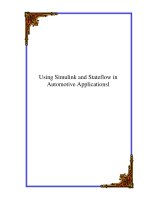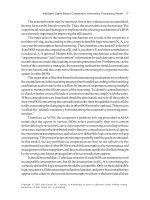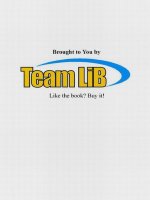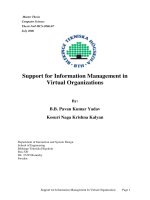Tài liệu Support for Information Management in Virtual Organizations doc
Bạn đang xem bản rút gọn của tài liệu. Xem và tải ngay bản đầy đủ của tài liệu tại đây (419.53 KB, 58 trang )
Master Thesis
Computer Science
Thesis No# MCS-2006:07
July 2006
Support for Information Management in
Virtual Organizations
By:
B.B. Pavan Kumar Yadav
Kosuri Naga Krishna Kalyan
Department of Interaction and System Design
School of Engineering
Blekinge Tekniska Högskola
Box 520
SE- 37225 Ronneby
Sweden
Support for Information Management In Virtual Organization Page 1
This thesis is submitted to the Department of Computer Science, School of Engineering at
Blekinge Institute of Technology in partial fulfillment of the requirements for the degree of
Master of Science in Computer Science. The thesis is equivalent to 20 weeks of full time
studies.
Authors E-mail Address
B.B.Pavan Kumar Yadav
Personal Number # 810419-P112
Kosuri Naga Krishna Kalyan
Personal Number # 801122- P911
University advisor: Email:
Rune Gustavsson Phone: + 46 0708-341151
School of Engineering Fax: +46 455 385667
Department of Computer Science
Blekinge Institute of Technology
SE – 37225 Ronneby
Sweden
Support for Information Management In Virtual Organization Page 2
S
PECIAL
T
HANKS
T
O
First of all we would like to thank Rune Gustavsson our supervisor at BTH for giving us the
opportunity to do this thesis work, and for the help with the insight in making of this thesis.
Thank you Mr. Rune to provide us support in presenting our ideas clearly and for discussing
with us when we got stuck there your enormous knowledge has helped us a lot.
We also thank Karin Jakobsson for helping us with scheduling meetings on time with our
supervisor without which it would have been difficult for us to give this thesis a final shape in
the stipulated time.
We also thank the fellow students at Blekinge Tekniska Högskola for giving us the support
for forming a base of our thesis by taking their precious time in providing us the valuable
feedback on the university. We would like to thank all our friends in Sweden as well as in
India for suggesting us through different phase of our thesis.
Last but not the least we would like to thank our parents who have supported us at every stage
with their blessings without them we couldn’t have made up till this position.
Thank you all, without your help this thesis wouldn’t have been possible to do!
Pavan Kumar Yadav and Kosuri Naga Krishna Kalyan
Support for Information Management In Virtual Organization Page 3
A
BSTRACT
Globalization and innovation are revolutionizing the higher education forcing to
create new market trends. Different nations have their own pattern and
framework of education in delivering the educational services. Educational
institutions are also seeking different organizational and behavioural changes for
their better future as they hunt for new financial resources, face new competition
and seek greater prestige domestically and internationally. The coming future
will decide which universities would survive the market trends, competition and
expectations of the students (Clients). The survival-of-the-fittest paradigm
framework plays a prominent role in ideas of how the higher education would be
delivered to the students in future with the Instruction Technology and distance
education. According to us the education trend has changed its phase of delivery
of services form the management point of view to student’s point of view.
Leading to delivery of educational service’s which would have more impact on
student’s education, knowledge and experience within the institution. In our
thesis we try to provide some information about how to support and manage the
information in Virtual Organizations. We also explore the frameworks of the
university and discussed a case study about the different ways of providing
better support for information management resulting in delivery of best students
driven services and unique facilities. We would be looking at the different
aspects of the university work flows and procedures and gain an insight on the
student’s expectation from the organization. This investigation would be helpful
for the students to know what are the services they should expect from the
universities and also helpful for management to know better the needs of the
students and their needs and to develop a framework for proper execution of
these services.
Key Words …
Virtual Organization (VO), Requirement Engineering,
Stake holders, Work flows, Web services, Semantic web, Student centric
services.
Support for Information Management In Virtual Organization Page 4
S
TRUCTURE OF THE
D
OCUMENT
In Chapter 1 we have described the basic introduction about Grid computing and Virtual
Organization. Identifying and listing the process of creating a Virtual Organization. A brief
introduction of Blekinge Tekniska Högskola (BTH) as organization and the problem
statement motivating us to come up with a thesis work.
In Chapter 2 we have given a brief description about work flows also describing some of the
workflow with in the university from both student’s and management point of view.
Chapter 3 describes who is a stakeholder and what his role within an organization is. We
tried to list out the stakeholders for the selected workflows mentioned in chapter 2. In this
chapter we have discussed the different implementing models with which the workflows are
implemented and we also suggested some new technology (Web-Services and Semantic Web
Applications) using which the workflows could be properly implemented for better service
delivery. Also we have given an approach to implement the web services in the form of a
“Remote laboratory setup” framework with which the students can do their experiments from
any where in the world through internet.
Chapter 4 gives the explanation about Functional and Non-Functional Requirements with
emphasis on the Non-Functional requirements which we feel is the most important aspect for
developing a system. We have classified the parameters of Non-Functional requirements and
illustrated them in detail.
In Chapter 5 we have taken BTH as an example of a university and prepared a case study
which includes the different issues which we have gathered after discussing with students
about the issues they have faced within the university and what improvements they expect
within the university by conducting one on one sessions and also getting the feedback from
the questionnaire. The feedback questionnaire is shown in Appendix-A. We have then
analyzed the different feedback given by the students. After analyzing have proposed a
system which could be implemented for better students interaction with university. Also we
have discussed about “Student Centric Services” which is the current trend utilised by most
of the renowned universities.
Chapter 6 gives the conclusion of our thesis and the Future Work that could be performed
according to us.
Support for Information Management In Virtual Organization Page 5
T
ABLE OF
C
ONTENTS
Page No
Chapter 1 INTRODUCTION
1.1) Setting up the Scene …………………………………………............................ 9
1.2) Background …………………………………………………………………..... 10
1.2.1) what is grid computing? What is its importance? ……………......... 10
1.2.2) what is VO? What is the required environment for VO? ................. 10
Chapter 1.5 PROBLEM STATEMENT AND CHALLENGES
1.5) Problem Statement…………………………………………………………....... 12
1.5.1) Motivation for thesis ……………………………………………..... 12
1.5.2) Challenge or Research Questions …………………………………. 12
1.5.3) Research methodology …………………………………………….. 12
1.5.4) Guidance to the readers …………………………………………… 14
1.6) Own contribution ……………………………………………………………… 14
1.7) Other Approaches ……………………………………………………………... 14
Chapter 2 WORK FLOWS
2.1) Introduction to Work-flows …………………………………………………… 15
2.2) BTH Organisation Work-Flow Design ……………………………………...... 17
2.2.1) Student Applying for Admission …………………………………. 17
2.2.2) Service for International Students
(Accommodation/Pickup Services) ……………………………......
18
2.2.3) Student Course Registration ……………………………………… 19
Chapter 3 IMPLEMENTING SELECTED WORKFLOWS
3.1) Identification of Stake Holders ………………………………………………...
21
3.1.1) who are stakeholders? ……………………………………………... 21
3.1.2) what is the roles of stakeholders? …………………………………. 21
3.2) Implementation Models ……………………………………………………….. 24
3.2.1) Data-Base model …………………………………………………... 25
3.2.2) Client-Server Model ……………………………………………..... 25
3.2.3) Variant of Web Services …………………………………………... 26
3.3) Remote Laboratory Framework ……………………………………………….. 31
3.4) Semantic Web ……………………………………………………………......... 34
Support for Information Management In Virtual Organization Page 6
Page No
Chapter 4 NON-FUNCTIONAL REQUIREMENTS
4.1) Introduction ……………………………………………………………………. 37
4.2) Challenges of Non-Functional Requirements …………………………………. 38
4.3) Classification of Non-Functional Requirements ……………………………... 38
4.3.1) Performance ……………………………………………………….. 39
4.3.2) Maintenance ……………………………………………………….. 39
4.3.3) Portability …………………………………………………………. 40
4.3.4) Scalability …………………………………………………………. 40
4.3.5) Security and Protection ……………………………………………. 41
4.3.6) Information Ownership ……………………………………………. 41
4.3.7) Infrastructure ownership …………………………………………... 42
4.4) Conclusion …………………………………………………………………….. 42
Chapter 5 BTH a Case Study
5.1) BTH an organization …………………………………………………………... 44
5.2) Problems students facing with existing system ……………………………….. 44
5.3) Proposed Information System (Dialogue Based) ……………………………... 46
5.4) Student Centric Services ………………………………………………………. 48
5.4.1) Structure of this section ……………………………………………… 48
5.4.2) what do we mean by student centric services? ………………............. 49
5.4.3) what’s the difference with the current applied framework? …............. 49
5.4.4) Accelerating implementation of Student centric services? ................... 50
5.4.5) Indicative results in achieving standard Student centric service? ……. 50
5.5) Students Expectation with BTH University …………………………………... 50
Chapter 6 Conclusion & Future Work …………………………...
52
References ………………………………………………………………………….
54
Appendix A – Questionnaire distributed to the BTH Students ………………...
58
Support for Information Management In Virtual Organization Page 7
L
IST OF
F
IGURES
Fig 1) Support of work flow by services………………………………………….. 13
Fig 2) Student Applying for Admission…………………………………………... 17
Fig 3) Student service for International Students (Accommodation/Pickup
Services)……………..………………………………………………………
18
Fig 4) Student Course Registration ……………………………………………….. 19
Fig 5) Identification of Stake Holders ……………………………………………. 22
Fig 6) Client-Service Model ……………………………………………………… 26
Fig 7) Fundamental participants of Web Services ……………………………….. 27
Fig 8) SOA Architecture…………………………………………………………... 29
Fig 9) Interaction of Stakeholders with Web-Services……………………………. 30
Fig 10) Prototype for Remote Laboratory………………………………………… 31
Fig 11) Remote Laboratory Framework…………………………………………... 33
Fig 12) Classification of Non Functional Requirements………………………….. 39
Fig 13) Classical process of getting the information (Rule Based)……………….. 47
Fig 14) Proposed Information System (Dialogue Based)…………………………. 47
Support for Information Management In Virtual Organization Page 8
C
HAPTER
1.
INTRODUCTION
1.1) Setting up the Scene
In this thesis work we are trying to find the different means to develop an
organization (especially Educational Institute) so that it would be prominent in
providing the most suitable and best services for the students. In turn helps itself
for growing its fame and name in the international market. We hope that this
document would provide information for students as well as the management of
the university about what are the services and what the students should expect
from the university also the management should know how the services and
information support should be delivered focusing on students requirements.
At the end of the thesis the user would get to know the importance of the
following:
1. Understanding Requirement Engineering
2. Understanding Technical Ramification
3. Understanding Validation
Let us first describe what the Requirement Engineering is about
All truths are easy to understand once they are discovered; the point is to
discover them and this leads to discovering/gathering the requirements.
Requirements engineering is a term used to describe all the tasks that deals with
the investigation, scope and definition of a new or altered computer system. It is
the most important part in the business development. The requirements are
identified by the business analyst or the developers and then those requirements
are positioned to design a solution. There are set of activities in requirement
engineering to produce reliable, high quality and trustworthy system.
Eliciting requirements: Identify system stake holders its goals and expectations
with clearly defined system boundaries.
Modelling or specifying requirements: Here focus will be on systematic
modelling of both functional and non functional requirements. Functional
requirements are specified by system processing states, events (input events,
output events, process execution signals) and system data. System data may
include identification of data objects, data types, data sources, end-user screen
displays, and meta-data, as well as construction of a data dictionary. Functional
requirements should also specify system data flow through system or subsystem
states as controlled or synchronized by events.
In contrast, Non-Functional requirements can be goals, capabilities, and
constraints that situate the functional system within some context of operation.
Analyzing requirements: Identify system reasoning of the internal consistency,
completeness, or correctness of a specification.
Support for Information Management In Virtual Organization Page 9
Validating requirements: Here we assess feasibility of modelled system
solution, as well as to identify realizable and improbable system requirements.
Next step would be to understand the different technical requirements that
should be gathered for developing a system. At last how to understand the
validation of the system.
1.2) Background
1.2.1) what is grid computing?
Grid computing can be defined as an environment which uses the geographically
distributed computers connected through internet collectively for high
performance computing and resource sharing. This involves computers from
multiple organizations crossing organizational boundaries and enables the
creation of distributed teams (called as VO- Virtual Organizations). The main
goal of Grid computing is to facilitate the creation of virtual organizations, till
date there is no much concentration and work done on the policies and
mechanism about how the virtual organizations will operate. The criteria behind
the creation of virtual organizations are collaborative delivery of specific
product or service. These organizations are created by bringing the different
aspects of services and facilities for achieving a single purpose.
1.2.2) what is Virtual Organization? What is the required environment for VO?
There is no single definition for the virtual organization for example [1] it is
defined as a “dynamic collection of individuals and institutions which are
required to share resources to achieve certain goals”. [2] Virtual Organization is
the temporary network of companies, customers, suppliers or employees linked
by information and communication technologies with a purpose of delivering a
service or product.
First we would like to give the brief description of the virtual organization. [4] A
“Virtual Organisation” is simply a group of users with similar interests and
requirements who are able to work collaboratively with other members of the
group and/or share resources (data, software, CPU, storage space, etc) regardless
of geographical location. The principle theory of virtual organization is some of
the key aspects they are: well defined processes and performance management
to deliver the quality service.
Support for Information Management In Virtual Organization Page 10
The process of creating Virtual Organisation:
•
Identify common goals and objectives.
•
Identify customers/clients and what are we going to do for them.
•
Identify the flow of work from beginning to end (Process)
•
What systems/IT/services will you need to service the customer without
acquiring people or buildings? (Systems)
•
Identify performance measurement systems to ensure that service levels
and profitability are maintained? (Metrics)
•
Without the addition of people and buildings, how are we going to
organise the Organisation.
Required Environment for virtual organisation
•
Company goals that cannot be achieved without working together by a
group of individuals, businesses or organisations.
•
Person required leadership skills to bring the group together.
•
A cluster coordinator -somebody who loves networking and is great at
organisation and making things happen.
•
IT systems that allow the individuals to share ideas and information
•
A budget to pay for meetings/IT infrastructure/marketing/performance
measurement/team building between members etc [5]
Support for Information Management In Virtual Organization Page 11
C
HAPTER
1.5
P
ROBLEM
S
TATEMENT
A
ND
C
HALLENGES
1.5) Problem Statement
1.5.1) Motivation leading to thesis
Usually if we look the university in the organizational perspective then we could
find that university is the service provider by means of the Staff/employees
usually employed by university itself to deliver the services, and students are the
service consumers/seekers. The main aim of the universities is to provide the
better standard education with the maximum support from the staffs and
administrative department easing the work of the students. Today’s technology
and concern for delivering proper services is moulded in to such organizations
without any proper gathering of student requirements this leads to development
of a information system which is fully operational but which exists with
improper work procedures and often increases the work pressure on the staff and
management. This pressure is indirectly mounted over the students making a
negative impact on the experience of the students at the university. So these
drive our interest to find out how well the information management could be
processed for providing a better support for a virtual organization.
1.5.2) Challenge (research question)
Our research drives us to find out what are the most important aspects of
requirement engineering? Also what are the most important aspects of
validation? From the context of student centric services
1.5.3) Research methodology
The thesis is an investigation research from the context of student services
where we would discuss about the organization, find the generic workflows and
framework within the organization and gather the requirements which are
important from the student’s point of view and also analyze their feedback and
understand the different aspects where the university lags and what is the best
part of university. Trying to explore and discover the answer of making trust
worthy environment for service delivery to the students.
The figure below describes the support of the workflow by means of services.
As usual university has defined staff and student’ work flow. While considering
some unclear tasks and responsibilities for the staffs leads to the failure of the
defined workflows. These in-turn increases the amount of workflow that
individual has to perform leading to increased pressure. This pressure is directly
or indirectly levied on the students and resulting in system failure.
Support for Information Management In Virtual Organization Page 12
Fig 1) Support of work flow by services
With the perpetual decline in subsidization the future of education would depend
on alternatives and non-traditional methods of delivering its products. The
reasons which are pressurising the most of the educational institute for the better
standards and the virtualization some of them being:
9 The increase in the demand for larger infrastructures and growing
number of enrolments force the educational organizations to
implement distant education with the similar standards.
9 Students are striving for the courses which match their schedule and
circumstances thus forcing the decline in the traditional learning.
Students now a day are also looking at the future prospectus, benefits of
pursuing the course with in a university either on-campus or through internet
learning. Due to this service organizations are facing much higher competition
with the rise in the non-traditional and alternative competitors, in maintaining
their fame and standard of education. Other factors also affect the organizations
some of them are:
9 Increase market demands and growing instability of available
resources.
9 Market conditions are unpredictable.
9 Making the services offered more flexible and creative by
maintaining the standards.
9 Broadening the services offered with maintaining internal
organizational behaviour and academic culture.
Support for Information Management In Virtual Organization Page 13
1.5.4) Guidance to the Readers
In the chapter 2 we have described about the generic workflows within the university, Later
in Chapter 3 we have selected some work flows and discovered who the stake holders for
implementing those workflows and in detailed description of the implementation models. In
chapter 4 we have discussed the most important aspect of a system i.e., Non-Functional
Requirements and why they are important for any system development. Chapter 5 we have
taken up a case study about Blekinge Tekniska Högskola (BTH) and we have investigated the
different aspects of this university among the fellow students, trying to list out what are their
expectations and what issues they have encountered. Later we have proposed a system which
according to us would be one of the best possible ways to gain and improve the student’s
appraisal. Also we have described what Student Centric Services are and listed out some of
the services which could be implemented. The final Chapter 6 gives the conclusion of our
thesis.
1.6) Own Contribution
Gathering all the information for performing our thesis was not an easy task as there is no
literature, no references and no books available for us to refer for gathering information. We
have discussed among ourselves and gathered most of the information about how to provide
better support for the information management within any organization. We have investigated
and provided a background for the platform implementation for the Student Centric Services
which could be implemented in Blekinge Tekniska Högskola for producing better standard of
the services and also design the proper means of delivering the services to the students.
In this thesis we have also described two different systems, first we have provided the detailed
framework of setting up a “Remote laboratory” for performing remote experiments. Second
we have designed a workflow of a “dialogue driven approach” model which would be helpful
for providing the service in a much better interaction with the students. These models could
be further put in to development using some technologies described by us in this thesis.
1.7) Other Approaches
There could be other approaches for our thesis, according to us if the university hires some
system development professionals who can take care of gathering the requirements from the
students and also from the management and plan accordingly in setting up the stake holders
within the organization with clear defined policies and responsibilities keeping in mind the
mission of the organization. Also there are lot of new technologies using which the system
“remote laboratory and dialogue based interactive information gathering system” can be
developed.
Support for Information Management In Virtual Organization Page 14
C
HAPTER
2.
W
ORK
F
LOWS
2.1) Introduction to Work-flows
Work flows can be defined in different ways in general workflow is the tasks
through a certain work process. (Or) Work flow is the graphical representation
of certain flow of a process in order to take a decision or conclude any work.
Specifically to say Workflow is the operational aspect of a work procedure with
details of how the tasks are structured, who performs the task, what is the order
of them and their information of the synchronization. Some workflows are
considered in the dimension of time.
In the context of information technology the workflow is a model to support the
internal part of the working /process methods of the software or the documents.
There are many more workflow paradigms which can be distinguished for
scientific or business. Here they depend on the purpose for which they have
been designed and implemented.
According to us the workflow for the educational service perspective can be
defined as a process which has to be adopted and regularly updated by the
university management or the students with which the needs and requirements
of the students can be met for their better performance and reducing the work
load from the university management and staff.
The main concern here would be to accumulate the expectations of the students
in the form of feedback and then to monitor them and create a system which
could deliver efficiently and effectively the service.
Our aim was to take the feedback of the registered students of the university
about their experience of the process through which they have gone through and
share their experience and expectations in order to create a better frame work by
trying to find out flaws (if any) in the current approach of university towards
student and vice versa.
Below we have mentioned the different scenarios of the work flows of some
processes carried out by the university:
1) Student Applying for Admission
2) Student requesting for Information
3) Student service for International Students
(Accommodation / Pickup Services)
4) Student course registration process
5) Student Examination registration process
6) Final Award of Degree process
Support for Information Management In Virtual Organization Page 15
Process
Decision
Data Base
Pre-Defined Process
M a n u a l In p u t
Input / output
Docum entation
F l o w c h a r t E l e m e n t s
Actor
Action
Send Event
Receive Event
Note
Flow Final
Support for Information Management In Virtual Organization Page 16
2.2) BTH Organisation Work-Flow Design
2.2.1) Student Applying for Admission
student
fills up the
application form
submits the
application
with transcripts
receives the
automated application
reference number
BTH DATABASE
Admission Department
receives the Application form
Approve
/ Reject?
Approve
Reject
BTH DATABASE
Result sent to
Admission department
course coordinator
receives application
ok
incomplete
documents
application
verification ?
Send the
Rejected information
to student
Post the Admission letter
And university Information to
Student
Enter the student in the
Admission Data base
Support for Information Management In Virtual Organization Page 17
2.2.2) Student service for International Students (Accommodation / Pickup Services)
student
BTH NEW
STUDENTS DATABASE
BTH DATABASE
Set reminder depending on the
Importance of the request
Request
answered
Request is processed and answered
yes
Save the session for
monitoring the students requests
Request sent to the
authorised person
Requests / Sends
the Information
to student service
s
Student receives the
status of the request
NO
All the information
are maintained and
monitored for the
better performance
of student service
and the system
Support for Information Management In Virtual Organization Page 18
2.2.3)
STUDENT COURSE REGISTRATION
student
Student is received and
enrolled in to university
Student have to
select the individual
courses according
to his choice
Course details are updated
in the university database
Student selects the
courses
BTH COURSE REGISTRATION
SYSTEM
Course responsible and
students get the registration
details
student gets the mail
with the course details
(schedule,material,Assignments)
Professor takes the responsibility
to check the students approach
towardsstudies and learning
Details and students
performance are
documented and
updated in centralized
database
Support for Information Management In Virtual Organization Page 19
This page is Intentionally Left Blank
Support for Information Management In Virtual Organization Page 20
C
HAPTER
3.
I
MPLEMENTING
SELECTED WORK
-
FLOWS
3.1) Identification of Stake Holders
3.1.1) who are stakeholders?
There are lot of definition about a stake holder some of them are:
A stake holder could be any one a person, a group, a business unit, an
institution, or organization that has a share or an interest in a particular sector or
system or set of activities.
A stake holder could be any one with a common interest for a public / private
sector organization for getting maximum benefits and achieve a goal.
For an educational institution like BTH we find that there are some of the stake
holders who are working altogether to gain the maximum benefits and also
achieve the mission of the university.
They are:
1. Students
2. Information Providers
3. Maintainer
4. Staff
5. System owners
6. Responsible person ( the supreme head)
We could say that a stake holder is a person, or department or organization who
has an interest in a process in the form of an obligation or having a benefit or
service.
3.1.2) what is the roles of stakeholders?
The stakeholders have responsibilities which lies in the participation and
commitment to a process which involves learning and listening to the other
groups. This participation implies responsibility not to the individual process of
the organization with which the stakeholder is concerned about but also for the
whole. So the stake holder participation implies taking up the responsibility to
work effectively, to participate in the decision process, to create a common
vision and to act towards achieving it for the common good.
Support for Information Management In Virtual Organization Page 21
STUDENT
IDENTIFICATION OF STAKE HOLDERS
Fig 5) Identification of Stake Holders
Information Provider:
Information providers are any one in the university who maintains the valid
information for the students. Some of the these information providers are
(Actor, Role)
1) (Course coordinator, provides course information)
2) (Program responsible, provides program information)
3) (Librarian, provides literature information)
4) (Students administrator, provides all student service information and
support)
5) (Administration dept, information regarding student’s admission)
6) (Students Expedition, answers student queries)
7) (International coordinator, information to the new students)
8) (Students union, takes care of students basic requirements for studies)
9) (Examination dept, provides the examination information and results)
INFORMATION
SYSTEM
RESPONSIBLE
HEAD
STUDENT
STAFF
SYSTEM
MAINTAINER
SYSTEM
OWNER
SET
OF
S
E
R
V
I
C
E
S
INFORMATION
PROVIDER
Support for Information Management In Virtual Organization Page 22
Maintainer:
For such a big organizational system there would be maintenance department in
order to check and maintain the proper functionality of the infrastructure and the
different facilities provided by the system.
We believe for all information which is to be provided should be maintained and
delivered in a safe and secure channel/process and has to be delivered to the right
person on request in order to maintain the transparency within the system.
All the above information providers require the information and resource
maintainers who would maintain the information and deliver to them. There
could be an either option of also being the information maintainer and also the
information provider.
We believe that the course responsible is the head of the particular program say
“Masters in technology” or “masters in Engineering”. They have to gather,
organize, maintain, implement and deliver the information to every student and
administration dept regarding the course structure.
The course structure is designed in such a way that the students gets the
maximum knowledge by learning the subjects, this is decided by the head of the
university (Rector/Dean) along with the course responsible we are not going to
concentrate on how they decide and how they go for structuring the course.
The prime responsibility of the maintainer is to maintain the proper information
in a proper channel. No wrong information or pseudo information should be
available for the concerned of the data.
Some of the lists of maintainers are:
1) (Course coordinator, maintains the course information on website)
2) (Program responsible, maintains the program schedule, slides and related
info )
3) (Computer administration dept, maintains the student lab info)
4) (Librarian, maintains and updates the library catalogue )
5) (Students administration dept, maintains the students course record)
6) (Examination dept, maintains the exam data and results information)
System Owners:
This is the most important and crucial part of the system where one information
provider or maintainer inputs any information in to the system or the website has
to make sure that the information is valid information. This part of the system is
left out unnoticed by the authorities of the university and they don’t take it
seriously.
We as a student have found that in the course website IDENET we get lot of
information regarding the courses which have already been scheduled before a
year or two.
Support for Information Management In Virtual Organization Page 23
So the concerned person who has inserted the course information or any valid
information has to keep that information for a particular valid period of time. Say
until the course results have been finalized and been published. So the very next
thing for the responsible is to remove all the information provided at the site till
the next time when the course is offered.
The owner ship of a particular work or process is very much important for better
results. Every person who is uploading or updating the website information or
any other information has to make sure that the information provided in the
information sheets or data base are updated and correct, ultimately achieving
best performance.
Responsible Head:
The head of the university is the responsible head of the system which is
implemented and is also one of the stake holders because he/she is concerned
about the development of the organization let it be a company or any public or
private sector organization.
All the management decisions which are taken are approved by head of the
institution. Without his/her concern no decision can be taken or altered. He is the
supreme body of the system.
3.2)
Implementation Models
Implementing the services for the students can be classified in to three models
they are (1) Database model (2) Client-Server model and (3) Variant of Web
Services which are further classified in to (i) Web-Services (ii) Semantic Web.
One of the major aspect what we as a students look in for in a university is the
use of information resources and also getting the valuable information at the
right time in a right precision.
The most common means of gathering information is through the fellow
students, friends, course responsible, student’s information desk, students’
administration, course home pages and also the program responsible.
Though most of the resources through which the students gather information are
unofficial. Most official process of getting the information is the course website.
We would like to have the website in such a way that the students get the
updated information right at their finger tips.
Technology:
Implementing these services would drive the interest for the best of the current
technology in the market with better user driven approach for their ease of use.
Some of the implementation models used is mentioned above. These services
developed should be information transparent, (i.e. hiding the internal working
process) and should be able to handle multiple requests or events.
Support for Information Management In Virtual Organization Page 24
3.2.1) Data-Base model
First basic model could be either to develop a static website and then put in all
the information in that but the technology and the market demands much more
than that. The most general model could be thought about is the Data-Base
model where the developer develops the service by inserting all the information
in a database and then uploads/retrieves the information from the database when
ever required. This seems to be much more static rather than dynamic.
A database model is a theory or specification describing how a database is
structured and used. Common models include
• Hierarchical model
• Network model
•
Relational model
[6] The Hierarchical Model, in which record types are linked in a treelike
structure (e.g., employee records might be grouped under a record describing the
departments in which employees work)
The Network Model, in which arbitrary linkages of record types may be created
(e.g., employee records might be linked on one hand to employees' departments
and on the other hand to their supervisors—that is, other employees)
The Relational Model, is one in which all data are represented in simple tabular
form, with relations like one-to-one, one-to-many etc.
3.2.2) Client-Server Model
It’s very easy to say that “The client-server is the relation ship between two or
more computers in which one program, the client makes the request to another
program, the server which fulfils the request.” Its very general description, to
implement the services in a client server model requires much more work than it
seems to be, creating a client/server architecture which is scalable, robust,
maintainable and effective system has proven to be a frustrating task for different
large and medium scale organizations worldwide.
• Before building a client-server system is a clear prospective of the
requirements of the organization and the people, precise understanding of
the system and its requirements, working knowledge of the abstract
architectures to define the structure for effective client-server systems, using
the services model to design and verify the architecture.
• Having the in-depth analysis of the working strategies and proper
understanding of using the proven strategies along with the basic guidelines
for designing the scalable, fault-tolerant distributed system for providing
better data integrity and security.
The simple example of the client server model is the World Wide Web (WWW).
If a user wants to check his bank statement online first his system acts like a
client and it sends the request to the bank server which authenticates and gives a
secure connection to the user so that he can do the bank transaction online.
Support for Information Management In Virtual Organization Page 25









